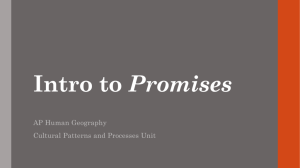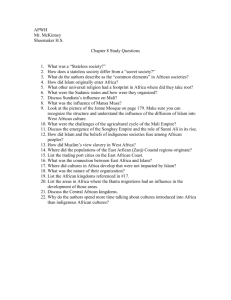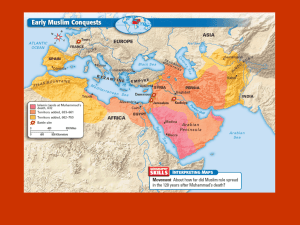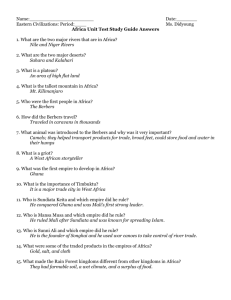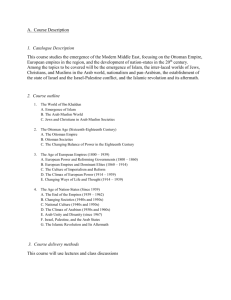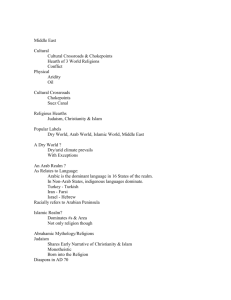World Cultures Midterm Vocabulary
advertisement
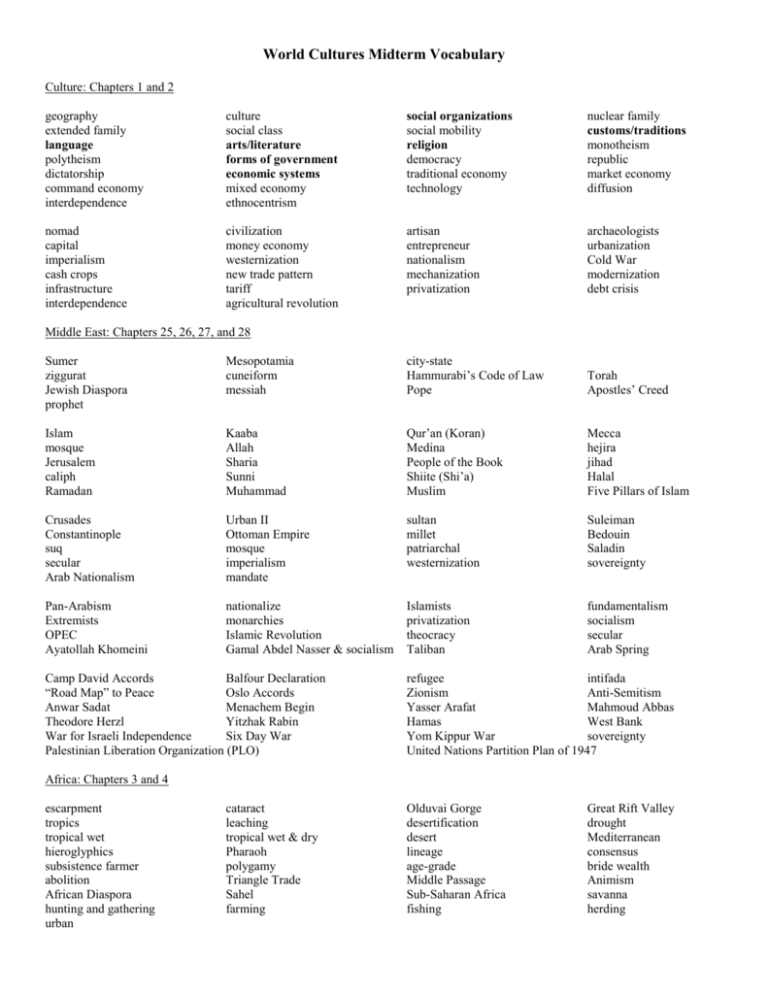
World Cultures Midterm Vocabulary Culture: Chapters 1 and 2 geography extended family language polytheism dictatorship command economy interdependence culture social class arts/literature forms of government economic systems mixed economy ethnocentrism social organizations social mobility religion democracy traditional economy technology nuclear family customs/traditions monotheism republic market economy diffusion nomad capital imperialism cash crops infrastructure interdependence civilization money economy westernization new trade pattern tariff agricultural revolution artisan entrepreneur nationalism mechanization privatization archaeologists urbanization Cold War modernization debt crisis Middle East: Chapters 25, 26, 27, and 28 Sumer ziggurat Jewish Diaspora prophet Mesopotamia cuneiform messiah city-state Hammurabi’s Code of Law Pope Torah Apostles’ Creed Islam mosque Jerusalem caliph Ramadan Kaaba Allah Sharia Sunni Muhammad Qur’an (Koran) Medina People of the Book Shiite (Shi’a) Muslim Mecca hejira jihad Halal Five Pillars of Islam Crusades Constantinople suq secular Arab Nationalism Urban II Ottoman Empire mosque imperialism mandate sultan millet patriarchal westernization Suleiman Bedouin Saladin sovereignty Pan-Arabism Extremists OPEC Ayatollah Khomeini nationalize monarchies Islamic Revolution Gamal Abdel Nasser & socialism Islamists privatization theocracy Taliban fundamentalism socialism secular Arab Spring Camp David Accords Balfour Declaration “Road Map” to Peace Oslo Accords Anwar Sadat Menachem Begin Theodore Herzl Yitzhak Rabin War for Israeli Independence Six Day War Palestinian Liberation Organization (PLO) refugee intifada Zionism Anti-Semitism Yasser Arafat Mahmoud Abbas Hamas West Bank Yom Kippur War sovereignty United Nations Partition Plan of 1947 Africa: Chapters 3 and 4 escarpment tropics tropical wet hieroglyphics subsistence farmer abolition African Diaspora hunting and gathering urban cataract leaching tropical wet & dry Pharaoh polygamy Triangle Trade Sahel farming Olduvai Gorge desertification desert lineage age-grade Middle Passage Sub-Saharan Africa fishing Great Rift Valley drought Mediterranean consensus bride wealth Animism savanna herding Listing Questions: You must Answer ALL listing questions Identify the seven elements of culture. Identify causes of cultural change. Identify the four goals of modernization. Identify problems/obstacles of developing nations. What are the Five Pillars of Islam? Identify three traditional patterns of that that have dominated the Middle East. Identify two basic beliefs shared by Judaism, Christianity, and Islam. Identify three strengths of the Ottoman Empire. Identify three ways European powers weakened the Ottoman Empire. Identify remaining issues of the Arab-Israeli Conflict Identify effects of the African slave trade. Essay Question: Choose ONE A. In the Arab-Israeli conflict, each side has its own point of view. (a) Describe the causes of the conflict from the point of view of both an Israeli and a Palestinian. (b) Explain what the remaining stumbling blocks are to peace from the point of view of an Israeli and a Palestinian. B. Since the 600’s, Islam has been a major force in shaping the patterns of life in the Middle East. However, as everywhere in the world, geography has played a role in shaping people’s patterns of life. Write an essay describing ALL of the patterns of life in the Middle East. Be sure to discuss the impact of geography and cultural change within your essay. C. Discuss the development and teachings of Islam. Discuss who was involved, why and how it happened, when and where it happened, Arab culture at the time, and the main teachings. D. Since independence, the nations of Africa have faced numerous challenges. Describe the challenges and discuss how African nations have tried to meet each of the challenges mentioned. E. Describe the African slave trade. Be sure to discuss how slavery of Africans differed from earlier forms of slavery, the economic basis, trade routes, numbers, destinations, and the effects of the trade. F. Using full sentences and examples from class support the following generalization: Generalization: The Middle East is considered to be the “crossroads” of the world because of its strategic location and cultural diffusion.

